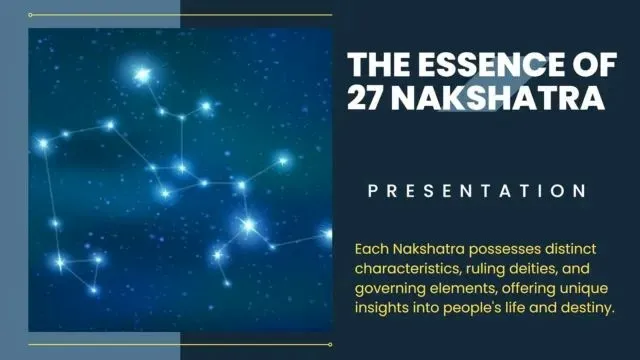27 Nakshatra preserves a great place. These celestial markers provide us with profound insights into the personalities, traits, and life paths of individuals. Derived from ancient Vedic astrology, the 27 nakshatras serve as guiding stars, each carrying its unique energy and symbolism. Derived from ancient Vedic scriptures, Nakshatras are lunar mansions that play a pivotal role in interpreting and understanding cosmic influences on human life.
In this comprehensive article, we delve into the intricate details of the 27 Nakshatras, exploring their characteristics, significance, and impact on astrology. Join us on this celestial journey as we unlock the secrets of these celestial entities.
What are 27 Nakshatras?

27 Nakshatra, also known as lunar mansions, are the 27 divisions of the elliptical path of the Moon around the Earth. Each Nakshatra occupies a specific portion of this celestial path and is associated with a particular set of stars.
These Nakshatras hold immense importance in Vedic Astrology, as they provide insights into various aspects of people’s life, including personality traits, compatibility, and life events.
27 Nakshatra covers a specific portion of the zodiac, and their position at the time of birth influences our individual characteristics and life experiences.
The 27 nakshatras are intricately woven into the fabric of Astrology, providing a deeper understanding of our true selves and our cosmic connection.
The 27 Nakshatras and Their Meanings

27 Nakshatra divides the zodiac into 27 equal parts, each representing a specific range of degrees. Each nakshatra carries its unique energy, symbolism, and ruling deity, influencing our personalities and life experiences. They provide valuable insights into our strengths, weaknesses, and potential life paths. Understanding the 27 nakshatra helps us navigate the complexities of life, make informed decisions, and tap into our cosmic connection. Exploring these celestial markers unveils a rich tapestry of wisdom and guidance for self-discovery and personal growth.
- Ashwini: The Horse Tamer
- Bharani: The Bearing Star
- Krittika: The Cutter
- Rohini: The Reddish One
- Mrigashira: The Searching Deer
- Ardra: The Moist One
- Punarvasu: The Return of the Light
- Pushya: The Nourisher
- Ashlesha: The Embracer
- Magha: The Mighty One
- Purva Phalguni: The Former Reddish One
- Uttara Phalguni: The Latter Reddish One
- Hasta: The Hand
- Chitra: The Bright One
- Swati: The Self-Going
- Vishakha: The Forked Branch
- Anuradha: The Following Radha
- Jyeshtha: The Eldest
- Mula: The Root
- Purva Ashadha: The Former Unsubdued
- Uttara Ashadha: The Latter Unsubdued
- Shravana: The Hearing
- Dhanishta: The Most Famous
- Shatabhisha: The Hundred Stars
- Purva Bhadrapada: The Former Blessed Foot
- Uttara Bhadrapada: The Latter Blessed Foot
- Revati: The Prosperous One
27 Nakshatra possesses distinct characteristics, ruling deities, and governing elements, offering unique insights into people’s life and destiny.
The Essence of 27 Nakshatras

Here’s the essence of 27 nakshatras:
1. Ashwini (The Horse-headed Twins): Ashwini, the first nakshatra in the zodiac, represents vitality, courage, and the power of healing. Individuals born under this nakshatra are known for their dynamism and natural leadership abilities. They possess a strong sense of adventure and a drive to overcome obstacles.
2. Bharani (The Bearer of New Life): Bharani embodies the energy of birth, creation, and transformation. It signifies fertility, creativity, and the relentless pursuit of one’s goals. Those influenced by Bharani possess a strong drive for success and have a natural ability to initiate change.
3. Krittika (The Star of Fire): Krittika represents the element of fire and signifies purification, strength, and determination. It imparts a fiery passion and a sense of responsibility to those born under its influence. Individuals influenced by Krittika possess a strong sense of justice and are driven to make a positive impact in the world.
4. Rohini (The Red-Eyed): Rohini epitomizes beauty, charm, and sensuality. It bestows artistic talents, nurturing qualities, and a deep connection with nature. Individuals influenced by Rohini possess a magnetic aura and have a profound appreciation for aesthetics and harmony.
5. Mrigashira (The Deer’s Head): Mrigashira symbolizes curiosity, exploration, and the search for truth. It ignites intellectual pursuits, creativity, and a yearning for knowledge. Those born under this nakshatra possess a keen analytical mind and a strong desire to uncover the deeper meanings in life.
Essence of 27 Nakshatras:
6. Ardra (The Moist One): Ardra embodies the transformative power of storms and tears. It represents emotional depth, spiritual growth, and the capacity for profound change. Individuals influenced by Ardra often exhibit great resilience, as they can navigate through challenging situations and emerge stronger.
7. Punarvasu (The Return of the Light): Punarvasu signifies renewal, rejuvenation, and the restoration of hope. It brings opportunities for growth, success, and the ability to overcome obstacles. Those born under Punarvasu are blessed with adaptability and possess a positive outlook on life.
8. Pushya (The Nourisher): Pushya is associated with nurturing and caring qualities. It signifies the importance of family, community, and taking responsibility for others. Individuals influenced by Pushya possess a natural ability to provide support and nourishment to those around them. They excel in roles where they can be caregivers and create a sense of belonging.
9. Ashlesha (The Embracing): Ashlesha represents the energy of transformation and hidden wisdom. It symbolizes the serpent, which sheds its skin to embrace new beginnings. Individuals influenced by Ashlesha possess depth and intuition. They can penetrate the depths of any situation and uncover hidden truths. Ashlesha’s energy can be intense and transformative, guiding individuals toward personal growth and spiritual evolution.
10. Magha (The Royal): Magha embodies regal qualities, leadership abilities, and a desire for recognition. It signifies the importance of legacy and making a lasting impact. Individuals influenced by Magha possess a sense of authority and command respect. They have a natural ability to lead and inspire others, often leaving a significant mark in their chosen field.
Summary of 27 nakshatras:
11. Purva Phalguni (The Former Reddish One): Purva Phalguni represents love, romance, and creative expression. It brings forth qualities of beauty, charm, and sensuality. Individuals influenced by Purva Phalguni possess a charismatic aura and enjoy the pleasures of life. They are passionate individuals who excel in artistic pursuits and have a natural ability to connect with others on an emotional level.
12. Uttara Phalguni (The Latter Reddish One): Uttara Phalguni signifies love, compassion, and the power of healing. It imparts a harmonious and compassionate disposition. Individuals influenced by Uttara Phalguni possess a strong sense of justice and a desire to make the world a better place. They excel in professions where they can serve others and bring about positive change.
13. Hasta (The Hand): Hasta represents dexterity, skillfulness, and the power to manifest. It signifies the importance of practicality and craftsmanship. Individuals influenced by Hasta possess a keen eye for detail and excel in creative endeavors. They can bring their ideas into tangible form through their hands-on approach.
14. Chitra (The Bright One): Chitra symbolizes beauty, creativity, and the power of illusion. It represents the artist within us and encourages self-expression. Individuals influenced by Chitra possess a natural flair for aesthetics and possess a unique vision. They excel in creative fields and can captivate others with their artistic endeavors.
15. Swati (The Independent One): Swati represents independence, freedom, and the power of choice. It signifies the importance of balance and harmony. Individuals influenced by Swati value their autonomy and possess a strong sense of justice. They excel in professions that allow them to work in a flexible and free-spirited manner.
Summary of 27 nakshatras:
16. Vishakha (The Star of Purpose): Vishakha represents determination, purpose, and the quest for truth. It signifies the importance of setting goals and working towards their fulfillment. Individuals influenced by Vishakha possess a strong sense of purpose and have a natural ability to inspire others. They strive for excellence and are driven to make a meaningful impact in their chosen endeavors.
17. Anuradha (The Devoted One): Anuradha embodies devotion, loyalty, and deep emotional connections. It signifies the importance of building strong relationships and fostering a sense of community. Individuals influenced by Anuradha possess a nurturing nature and excel in roles where they can support and uplift others. They value trust and create lasting bonds with those around them.
18. Jyeshtha (The Eldest One): Jyeshtha represents maturity, wisdom, and authority. It signifies the importance of embracing responsibility and taking a leadership role. Individuals influenced by Jyeshtha possess a natural gravitas and command respect. They can handle challenging situations with poise and make sound decisions based on their experience and insights.
19. Mula (The Root): Mula embodies transformation, spiritual growth, and the quest for self-discovery. It signifies the importance of delving deep into the core of our being to uncover our true essence. Individuals influenced by Mula possess a deep sense of introspection and have a natural inclination toward spiritual practices. They are adept at overcoming obstacles and emerge stronger through the process of self-realization.
20. Purva Ashadha (The Former Invincible One): Purva Ashadha represents resilience, determination, and the power to overcome challenges. It signifies the importance of perseverance and the pursuit of one’s goals. Individuals influenced by Purva Ashadha possess a strong sense of purpose and exhibit unwavering determination in the face of adversity. They can inspire others through their tenacity and inner strength.
In brief 27 Nakshatra:
21. Uttara Ashadha (The Latter Invincible One): Uttara Ashadha embodies victory, achievement, and the rewards of hard work. It signifies the importance of setting ambitious goals and striving for excellence. Individuals influenced by Uttara Ashadha possess a strong drive for success and have the ability to reach great heights in their chosen endeavors. They inspire others through their accomplishments and serve as a beacon of motivation.
22. Shravana (The Hearing): Shravana represents listening, learning, and acquiring knowledge. It signifies the importance of active communication and receptive learning. Individuals influenced by Shravana possess a keen intellect and have a thirst for knowledge. They excel in roles where they can absorb information, engage in meaningful conversations, and share their wisdom with others.
23. Dhanishta (The Most Famous One): Dhanishta embodies fame, recognition, and the pursuit of excellence. It signifies the importance of honing one’s talents and achieving success. Individuals influenced by Dhanishta possess a natural magnetism and have the ability to captivate others with their presence. They strive for greatness and leave a lasting impact in their respective fields.
24. Shatabhisha (The Hundred Healers): Shatabhisha represents healing, rejuvenation, and the power of transformation. It signifies the importance of compassion and the ability to bring about positive change. Individuals influenced by Shatabhisha possess a strong desire to help others and have a natural inclination towards holistic healing modalities. They possess the ability to create a nurturing environment and facilitate deep transformation in those around them.
In brief 27 Nakshatra:
25. Purva Bhadrapada (The Former Blessed One): Purva Bhadrapada represents spirituality, enlightenment, and the pursuit of higher knowledge. It signifies the importance of inner growth and the connection with the divine. Individuals influenced by Purva Bhadrapada possess a deep sense of introspection and are drawn to spiritual practices and philosophical pursuits. They can tap into higher realms of consciousness and inspire others on their spiritual journey.
26. Uttara Bhadrapada (The Latter Blessed One): Uttara Bhadrapada embodies compassion, selflessness, and the power of healing. It signifies the importance of service to others and the ability to bring about positive change in the world. Individuals influenced by Uttara Bhadrapada possess a deep empathy for others and have a natural inclination towards humanitarian causes. They possess the ability to offer support and healing to those in need, making a significant impact in their lives.
27. Revati (The Wealthy): Revati represents abundance, prosperity, and the culmination of a journey. It signifies the importance of completion and the rewards of perseverance. Individuals influenced by Revati possess a strong sense of optimism and can attract abundance in all areas of life. They excel in bringing projects to fruition and enjoy the fruits of their labor.
The Mythological Story Behind 27 Nakshatras

- In ancient Hindu mythology, the Nakshatras, also known as lunar mansions, are an integral part of the celestial sphere. These 27 Nakshatras are believed to be the daughters of the cosmic being Daksha and his wife, Queen Prasuti. Each Nakshatra possesses its own unique qualities and influences various aspects of human life.
- The tale begins with Daksha, a wise and powerful king who ruled over the heavens. Desiring to extend his lineage and create a harmonious balance in the universe, Daksha decided to marry his daughters to the moon god, Chandra. Chandra, renowned for his radiance and serenity, accepted Daksha’s proposal and eagerly married the 27 celestial maidens.
- However, as time passed, Chandra found himself irresistibly drawn to one of his wives, Rohini, due to her extraordinary beauty and charm. Consumed by his infatuation, he neglected the other Nakshatras, causing them great anguish and distress. The neglected wives sought solace and guidance from their father, Daksha.
- Deeply saddened by Chandra’s behavior, Daksha approached Lord Brahma, the creator of the universe, for a resolution. Brahma, in his divine wisdom, decided to punish Chandra for his negligence and restore harmony to the Nakshatras.
Mythological Story
- Brahma cursed Chandra with a debilitating disease that weakened his luminosity, forcing him to wax and wane over a lunar month. He also decreed that Chandra would lose his beauty and radiance for some time, symbolizing his inability to remain constant.
- Witnessing the plight of their husband, the Nakshatras pleaded with Brahma to lift the curse and restore Chandra’s former glory. Brahma, moved by their sincere prayers, granted them their wish. However, he also bestowed upon each Nakshatra unique attributes and characteristics, ensuring that their influence on human life would be everlasting.
- From that day forward, each Nakshatra was assigned a specific segment of the zodiac, forming the 27 lunar mansions. These celestial abodes, named after the Nakshatras, would serve as guiding beacons for individuals born under their influence.
- The Nakshatras united once again, forgave Chandra, and continued to bless humanity with their divine energies. They became celestial markers, influencing various aspects of life such as birth, marriage, and success. People began to study the Nakshatras and their corresponding positions to understand the cosmic forces at play and seek guidance in their endeavors.
- The mythological tale behind the 27 Nakshatras portrays a balance between love, responsibility, and divine intervention. It reminds us of the importance of harmony and the consequences of neglecting our duties. The Nakshatras, with their enduring influence, serve as a reminder of the interconnectedness of the cosmos and the profound impact celestial bodies have on human existence.
27 Nakshatras: The Major Facts

Here are some major facts about the 27 Nakshatras:
- Origin: The Nakshatras are a system of 27 lunar mansions or divisions of the zodiac, derived from ancient Hindu astrology.
- Naming: Each Nakshatra is named after a prominent star or constellation that falls within its division.
- Position: The Nakshatras are spread evenly across the zodiac, with each Nakshatra occupying approximately 13 degrees and 20 minutes.
- Symbolism: Each Nakshatra has a specific symbol or representation associated with it, such as a star, animal, or deity.
- Ruling Deities: Every Nakshatra is linked to a ruling deity or a group of deities that govern its energy and qualities.
- Characteristics: Each Nakshatra possesses distinct characteristics, traits, and energies that influence the nature, behavior, and destiny of individuals born under their influence.
- Division of Time: The 27 Nakshatras divide the lunar month into 27 equal parts, with each Nakshatra representing a day.
- Importance in Astrology: The Nakshatras play a significant role in Vedic astrology, guiding various aspects of life, including birth charts, horoscope analysis, and predictions.
- Doshas and Remedies: Nakshatras are also associated with specific doshas (imbalances) and remedies to mitigate their negative effects. These remedies can include rituals, mantras, gemstones, and other remedial measures.
- Nakshatra Lord: Each Nakshatra has a ruling planet or deity known as the Nakshatra lord, which further influences the Nakshatra’s qualities and characteristics.
Other Facts:
- Padas: Each Nakshatra is divided into four parts called “padas,” which provide additional insights into an individual’s personality and life experiences.
- Lunar Influence: The Nakshatras are primarily associated with the moon’s energy and reflect its cyclical nature, affecting emotions, intuition, and the mind.
- Compatibility: The compatibility between individuals is often analyzed based on the Nakshatras they are born under, considering factors like Nakshatra’s elements, ruling planets, and lunar compatibility.
- Mythological Connections: Many Nakshatras have mythological stories associated with them, featuring prominent deities, heroes, or events from Hindu mythology.
- Predictive Tools: Astrologers use the Nakshatras as predictive tools to assess timing, determine favorable periods, and provide insights into life events.
Significance and Interpretation of Nakshatras
Nakshatras act as celestial guides, shedding light on various aspects of people’s life. Astrologers analyze the placement of planets in specific Nakshatras at the time of a person’s birth to gain deeper insights into their personality traits, strengths, weaknesses, and life events. These lunar mansions help astrologers provide accurate predictions, offer guidance, and suggest remedial measures for challenges that people might encounter along their life’s journey.
In Conclusion
The 27 nakshatras form a celestial map that guides us through the complexities of life. Understanding their significance and influence empowers us to embrace our unique qualities, navigate challenges, and tap into our highest potential. Each nakshatra carries a distinct energy and message, offering us a deeper understanding of ourselves and the world around us.
When interpreting the nakshatras in your birth chart, it’s essential to consider the position of other planets and their aspects, as they further enhance or modify the nakshatra’s influence. Each person’s unique combination of nakshatras and planetary placements creates a fascinating cosmic tapestry that reveals the intricate layers of their life story.
They can provide valuable insights into how the nakshatras influence your strengths, weaknesses, and life experiences, guiding you toward self-discovery and personal growth.
Incorporating the wisdom of the 27 nakshatras into your life can bring about a profound transformation. By embracing their energies, you can align yourself with the cosmic flow and make conscious choices that lead to fulfillment, harmony, and spiritual evolution.
Read More:
Aswini NakshatraBharani NakshatraRohini NakshatraMrigashira Nakshatra